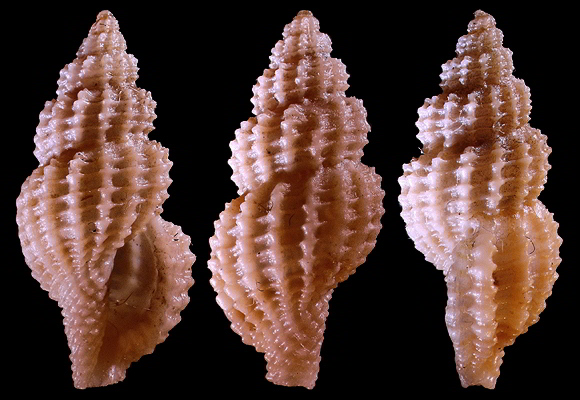
Predator at least in the infralittoral.
« Shell fusiform, solid, large for the genus (up to 20,5mm, maximal found size). The protoconch is paucispiral of about 2 whorls, light coloured, with a slight mesh of horizontal and vertical thin lines. The teleoconch has around 6-7 whorls. The transition protoconch-teleoconch is subtle but visible. The sculpture is made up of about 16-20 opisthocline axial costae and 16 to 20 cords, 5-7 of them being above the suture. The interspaces between the vertical or horizontal costae are larger than the costae themselves. Their crossing builds a rectangular meshing and their intersections give rise to acuminate and lengthened nodules, especially on the first whorls, giving the shell a spiny appearance. The suture is large, smooth, adorned with comma-shaped white markings. It demarcates a large and sloping subsutural ramp. The siphonal fasciole is well defined and bears 7-8 cords of big nodules. The aperture, ovate, is ending with a short and wide canal. The columellar edge is rather straight anteriorly. The labial margin is not very thick and bears 9 to 13 teeth. The labial notch is deep. The colour is shared between tan and maroon. A brownish-cream band is seen on the last whorl over two costae in height. The extremity of the canal is also cream coloured. The inside of the rectangular meshes is sometimes adorned with white V-shaped or crescent-shaped figures. » – Pelorce & Horst: “Raphitoma echinata (Brocchi, 1814) and Raphitoma echinata sensu auctores sur la côte méditerranéenne du département des Alpes-Maritimes (France)”, Xenophora Taxonomy 28, april 2020, p.29.
As often, the colours and patterns are not determining factors. Derivatio nominis: after Mr. P. Azuar, surgeon gynecologist, diver and underwater photograph, who is one of the first to have found this species.
As often, the colours and patterns are not determining factors. Derivatio nominis: after Mr. P. Azuar, surgeon gynecologist, diver and underwater photograph, who is one of the first to have found this species.
Saint-Gervais beach, Fos-sur-Mer, Bouches-du-Rhône, Provence, S. France. 12mm. E. Vial legit (FR).